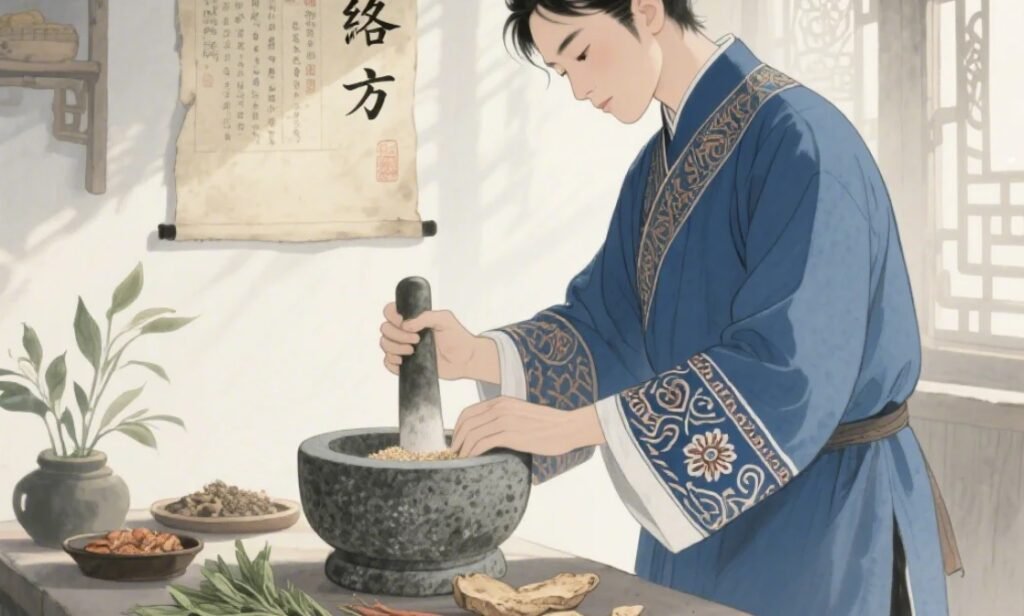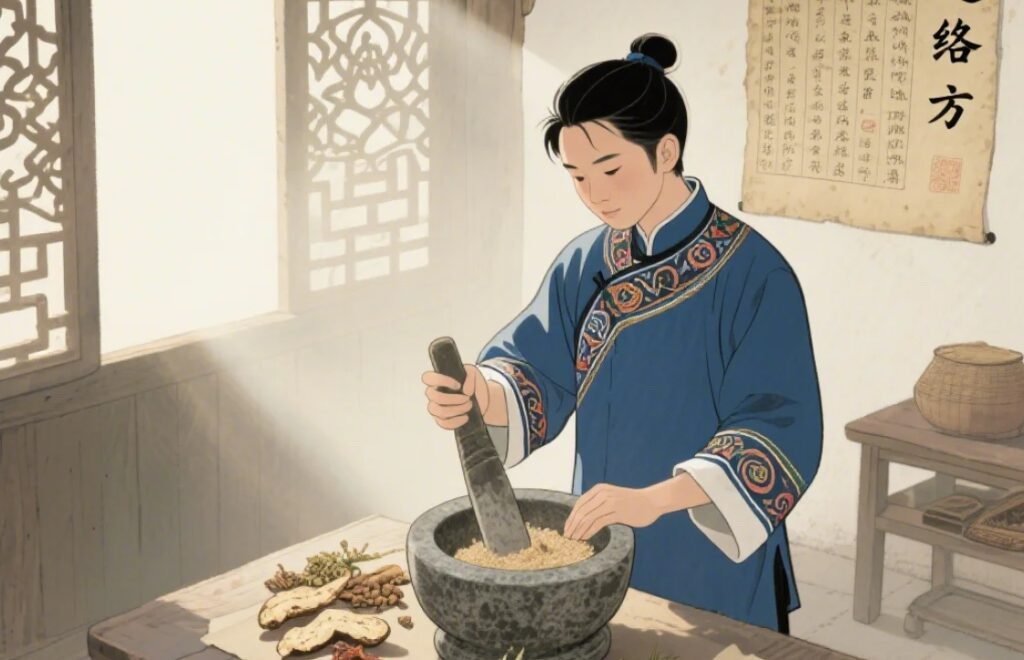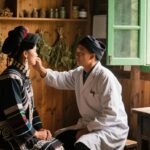Mengcha·Menggangqiang (Abdominal Pain)
Overview
In Miao medicine, abdominal pain is referred to as Mengcha·Menggangqiang or Jiugagangmeng. Also known as Heili·Baidongbaiyang, this condition arises from damage to the cold meridians resulting in obstructed qi flow and impaired circulation of qi and blood, or from damage to the hot meridians leading to qi stagnation that transforms into fire and causes heat to accumulate in the gastrointestinal tract, thereby inducing abdominal pain. Jiugagangmeng refers specifically to pain in the intestines and lower abdomen. This section focuses on Mengcha·Menggangqiang.
In Traditional Chinese Medicine (TCM), abdominal pain refers to a syndrome characterized primarily by pain occurring below the epigastrium and above the pubic area. Various factors may lead to dysfunction in the internal organs, causing obstruction in the flow of qi and blood in the meridians, and impaired nourishment of the viscera and channels, ultimately resulting in abdominal pain.
In Western medicine, abdominal pain appears in many conditions such as acute or chronic pancreatitis, gastrointestinal spasms, partial intestinal obstruction, tuberculous peritonitis, abdominal Henoch–Schönlein purpura, irritable bowel syndrome, and dyspeptic abdominal pain. When abdominal pain is the main symptom and surgical or gynecological causes have been excluded, the diagnostic and therapeutic principles discussed here may be referenced.
Huhou Jipeng (Miao Medicine Symptom Classification)
Mengcha·Menggangqiang is considered a major disorder and can be divided into two minor syndromes: hot meridian abdominal pain and cold meridian abdominal pain. These are further categorized into early-stage and late-stage intestinal pain.
Aijiangduo (Etiology)
The causes of abdominal pain are diverse. Cold toxins, heat toxins, qi injury, blood injury, food stagnation, and parasitic toxins can all disturb the balance of qi and fluids, leading to pain. External pathogenic factors, dietary irregularities, and emotional disturbances are the most common causes, followed by deficiency of middle yang and traumatic blood stasis.
Gengduomeng (Pathogenesis)
Mengcha·Menggangqiang is caused by damage to the cold or hot meridians. Damage to the cold meridians leads to blocked qi dynamics and impaired qi-blood circulation, resulting in pain. Damage to the hot meridians causes qi stagnation that transforms into fire, leading to heat accumulation in the intestines and stomach, thus inducing pain.

Diagnostic Key Points
1. Diagnostic Criteria
The main symptom is pain occurring below the epigastrium and above the pubic hairline, with a soft abdominal wall and possible tenderness but no muscle rigidity or rebound pain.
Commonly accompanied by abdominal distension, flatulence, irregular appetite, and abnormal bowel movements, indicating spleen-stomach dysfunction.
Onset is usually gradual, and pain is often triggered or worsened by dietary habits, emotional stress, exposure to cold, or fatigue.
Laboratory tests such as abdominal X-ray, ultrasound, colonoscopy, and stool analysis reveal abnormalities in related abdominal organs. Surgical, gynecological, and other internal medical causes must be ruled out.
2. Relevant Examinations
Laboratory Tests: Complete blood count, urinalysis, stool tests, ketone body assessment, and serum amylase are commonly used.
Puncture: Diagnostic puncture may be performed for peritonitis, internal bleeding, abdominal abscesses, or certain masses to obtain samples for smears, bacterial cultures, or pathology.
X-ray: For diagnostic difficulties or suspected thoracoabdominal disease, chest and abdominal fluoroscopy may be conducted to observe thoracic abnormalities, free subdiaphragmatic air, diaphragmatic motion, bowel gas, and fluid levels. Barium enema may be used for suspected sigmoid volvulus or low intussusception. Barium meals are contraindicated in suspected bowel obstruction, fistula, or perforation.
Ultrasound: Used primarily for evaluating biliary and urinary calculi, bile duct dilation, pancreatic and hepatic splenomegaly, and small amounts of ascites or inflammatory masses.
Endoscopy: Endoscopy is important for identifying causes of abdominal pain. If the patient’s condition allows, ERCP, cystoscopy, or laparoscopy may be conducted.
CT, MRI, and Nuclear Scans: These are effective for diagnosing intra-abdominal or retroperitoneal lesions involving the liver, spleen, pancreas, tumors, abscesses, effusions, and gas accumulations. The choice of modality should be tailored to the patient.
ECG: For elderly patients, ECG should be performed to assess myocardial perfusion and exclude myocardial infarction or angina.
Differential Diagnosis
Mengbudou (Epigastric Pain)
The stomach is located in the upper abdomen and connects with the intestines. Abdominal and gastric pain may present similarly and are often accompanied by each other, hence the term “heart-abdomen pain.” However, differentiation is necessary:
Gastric pain occurs in the upper epigastrium; abdominal pain occurs below the epigastrium and above the pubic hairline.
Gastric pain is often associated with bloating, belching, and acid regurgitation—symptoms of stomach qi rebellion; abdominal pain is typically accompanied by distension, flatulence, and altered bowel movements.
X-rays, gastroscopy, colonoscopy, and ultrasound of the affected areas aid in differential diagnosis.
Classification and Treatment
1. Hot Meridian Abdominal Pain
Menglidu (Symptoms): Abdominal distension and pain, burning sensation in the mouth and thirst, pain radiating to the flanks, resistance to pressure, poor appetite, acid regurgitation.
Xingleng (Meridian Association): Hot meridian, hot disease.
Jiahemeng (Treatment Principle): Clear heat and eliminate dampness (Xuga Kaitunei), relieve pain (Dangmeng).
Oudu Xijia, Gangou (Prescription and Explanation):
Xiangfu warms and soothes the liver, relieves pain; Wu zhuying warms and dispels cold, relieves pain (mild toxicity); Xiangzhang gen warms the middle, harmonizes the stomach; Kuzuzi clears liver fire and relieves pain; Shanwugui clears heat, detoxifies, cools blood, reduces swelling, and relieves pain.

Xiangfu (Cyperus rotundus, xiang fu) 10g
Wu zhuying (Evodia rutaecarpa, wu zhu ying) 6g
Xiangzhang gen (Cinnamomum camphora root, xiang zhang gen) 10g
Kuzuzi (Melia toosendan, ku dong zi) 10g
Shanwugui (Aconitum kusnezoffii, shan wu gui) 12g
Decoction for oral use.
2. Cold Meridian Abdominal Pain
Menglidu (Symptoms): Intermittent abdominal pain, relieved by warmth and pressure, aversion to cold, low appetite, fatigue, absence of fever, no thirst, clear urine, loose stools.
Xingleng (Meridian Association): Cold meridian, cold disease.
Jiahemeng (Treatment Principle): Dispel cold and relieve pain (Zhangshe Dangxiang).
Oudu Xijia, Gangou (Prescription and Explanation):
These herbs warm the middle, dispel cold, promote qi circulation, relieve pain, strengthen the spleen, and stimulate digestion.
Huajiao (Zanthoxylum bungeanum, hua jiao) 4g
Dangshen (Codonopsis pilosula, dang shen) 12g
Zhizhuxiang (Kaempferia galanga, zhi zhu xiang) 15g
Guizhi (Cinnamomum cassia twig, gui zhi) 10g
Ganjiang (Zingiber officinale dried rhizome, gan jiang) 10g
Shichangpu (Acorus tatarinowii, shi chang pu) 12g
Decoction for oral use.
Prevention and Care
Prevention and care focus on proper diet, suitable warmth, and emotional regulation.
For cold-induced pain, stay warm; for deficiency pain, eat easily digestible foods; for heat pain, avoid greasy and spicy foods; for food retention, eat moderately; for qi stagnation, maintain a pleasant mood.
Avoid alcohol and tobacco; eat nutritious, easily digested foods that do not harm the spleen and stomach.
Balance rest and activity, maintain a regular lifestyle, and avoid overwork or excessive rest.
Note
Miao medicine attributes abdominal pain to various causes and classifies it as upper or lower abdominal pain, though both share many symptoms and require careful differentiation. Causes include damage to cold or hot meridians, toxic invasion, or unclean food. Treatment focuses on detoxifying and pain relief.
Appendix: Jiugagangmeng (Intestinal and Lower Abdominal Pain)
Jiugagangmeng refers to syndromes characterized primarily by pain in the intestines and lower abdomen, comparable to intestinal abscesses in TCM. It is classified into early- and late-stage intestinal abscesses.
This condition often results from unclean food or internal invasion of damp-heat toxins that disrupt the balance of qi and fluids. Depending on the severity of the pathogenic factors, various symptoms may arise:
Damp stagnation in the intestines leads to diarrhea, bloating, and borborygmus.
Downward pressure of water toxins, heat toxins, or unclean food leads to diarrhea.
Classification and Treatment
1. Early-Stage Intestinal Pain
Menglidu (Symptoms): Pain worsened by light palpation, abdominal rigidity, difficulty standing upright, palpable mass in the right lower abdomen, fever, chills, nausea, vomiting, poor appetite, yellow urine, dry stool.
Xingleng (Meridian Association): Hot meridian, hot disease.
Jiahemeng (Treatment Principle): Clear heat and detoxify (Xuga Kaitaga), reduce inflammation and pain (Yangke Dangmeng).
Oudu Xijia, Gangou (Prescription and Explanation):
2. Late-Stage Intestinal Pain
Menglidu (Symptoms)
Severe, persistent lower-abdominal pain
Emaciation and pale complexion
Shortness of breath and reluctance to speak
Palpable mass or fullness in the right lower quadrant
Xingleng (Meridian Association)
Cold meridian, cold disease
Jiahemeng (Treatment Principle)
Promote qi circulation and toxin elimination (Ti Ben Xu Pi)
Invigorate blood and resolve stasis (Wei Jiao Yang Diao Xiang)
Oudu Xijia, Gangou (Prescription and Explanation)
Mianhuasang (Gossypium herbaceum root, 30g) – warms the channel, relieves pain
Dangshen (Codonopsis pilosula, 30g) – tonifies middle qi and spleen
Zaojiaoci (Gleditsia sinensis thorn, 15g) – activates blood, reduces swelling
Pugongying (Taraxacum mongolicum, 50g) – clears heat, resolves toxins, alleviates pain
Baijiangcao (Patrinia scabiosaefolia, 50g) – clears heat, detoxifies, disperses masses
Decoction: Combine and simmer in water; strain and drink the liquid.
Preventive Care
Dietary regulation: Eat moderate, easily digested meals; avoid spicy, greasy, or overly sweet foods; maintain appropriate ambient temperature; manage emotions.
Symptom-based adjustments:
Cold-type pain: keep abdomen warm;
Deficiency-type pain: eat nourishing, easy-to-digest foods;
Heat-type pain: avoid rich, spicy foods;
Food-stagnation: reduce intake;
Qi-stagnation: practice relaxation techniques.
Lifestyle: Avoid smoking and alcohol; maintain balanced work and rest; establish regular daily routines.
Practitioner’s Note
Miao medicine regards abdominal pain as resulting from damage to either cold or heat meridians, toxic invasions, or dietary irregularities. Although upper and lower abdominal pain share overlapping symptoms, careful differentiation is essential. The primary (used in traditional contexts) principles are detoxification and analgesia—clearing heat in heat patterns, dispersing cold in cold patterns, harmonizing qi, and invigorating blood to resolve stagnation.


Leave a Reply